It's ages since I knitted socks: more than a year since my last completed pair.
I think these fall into the category of plain socks. The pattern is the 'Lichen Ribbed Sock' from Nancy Bush's incomparable Knitting Vintage Socks. According to Nancy Bush the socks include 'a Welsh Heel and a Star Toe of Three Points'.
I think these classic ribbed socks are ideal for variegated yarns such as the beautiful yarn from the Australian dyer, Skein that I used for these socks. I bought this yarn a year or so ago when visiting Amsterdam so it bears the burden of many yarn air miles.
I began these socks on my trip to the USA and Mexico late last year but made very little progress on them. I know most people think that travel is an ideal time for knitting, but I think I'm too easily distracted. Nowadays, the minute I board a plane I search for the movies on offer. I can happily spend the endless hours of cross-Pacific flights watching movies and anyway, the light just isn't good enough for me to knit. I get motion sickness if I knit on buses, and even though I can knit on trains I'm usually too distracted by the view outside the window (and sometimes inside the carriage). But enough excuses, I didn't finish these socks until after my return.
Finally, a photograph to add to the controversy of socks with sandals.
I have no intention of wearing my socks this way - if it's warm enough for sandals it's too hot for knitted socks - but they do look quite spiffy.
Tuesday, February 18, 2014
Wednesday, January 22, 2014
Knitting, pottering
Only a few days after I wrote my last post outlining what I'd like to achieve with my knitting this year I've wandered off-course; I'm pottering around. I've begun to knit a cardigan for a baby who's the first grandchild of a very old friend. This certainly wasn't on my list of things to knit this year, but baby knitting is always seductive and this particular pattern has lots to recommend it.
I'm knitting the MacDougal Cardigan - a pattern by Connie Chang Chinchio who's a well-known and admired knitwear designer who has published several patterns for babies and children since her daughter was born a couple of years ago. I like the fact that she brings the taste and technical knowledge developed through years of designing adult garments to her children's patterns. In this particular cardigan I like the combination of the rather retro oat-stitch patterned panels on the front of the cardigan with its practical boxy shape and the unfussy contrast trim of reverse garter stitch.
In my defence of pottering away from my year's plan I can add that I used yarn I already had (some grey Debbie Bliss Baby Cashmerino) and the pattern does include useful knitting skills such as a three-needle bind-off at the shoulders and the option (which I shall take) of knitting the sleeves by picking up stitches around the armhole and knitting them in the round.
I'm a bit doubtful about the colour. I think a grey cardigan is very useful for a baby, but I know not everybody shares my belief in grey as suitable for all ages and occasions. Let's hope the cuteness of the pattern compensates for the rather utilitarian colour.
I'm knitting the MacDougal Cardigan - a pattern by Connie Chang Chinchio who's a well-known and admired knitwear designer who has published several patterns for babies and children since her daughter was born a couple of years ago. I like the fact that she brings the taste and technical knowledge developed through years of designing adult garments to her children's patterns. In this particular cardigan I like the combination of the rather retro oat-stitch patterned panels on the front of the cardigan with its practical boxy shape and the unfussy contrast trim of reverse garter stitch.
In my defence of pottering away from my year's plan I can add that I used yarn I already had (some grey Debbie Bliss Baby Cashmerino) and the pattern does include useful knitting skills such as a three-needle bind-off at the shoulders and the option (which I shall take) of knitting the sleeves by picking up stitches around the armhole and knitting them in the round.
I'm a bit doubtful about the colour. I think a grey cardigan is very useful for a baby, but I know not everybody shares my belief in grey as suitable for all ages and occasions. Let's hope the cuteness of the pattern compensates for the rather utilitarian colour.
Wednesday, January 15, 2014
Knitting 2013
I've been putting off writing this post because I'm rather embarrassed by the paucity of my knitting output in 2013. Only eleven completed projects, which is significantly fewer than the sixteen items of 2012, and that in turn was fewer than 2011. A definite downward trend and rather pitiable compared with some of my knitting friends. (See, for instance, the amazing output from MissFee who proves the adage of already busy people being the most likely to achieve additional tasks).
Still, I've decided to continue the blog tradition I seem to have established of awarding prizes for my year's knitting. At the very least, this makes me reflect on which items of knitting have worked in various ways.
First, the award for the project of which I'm most proud. This goes to my Northmavine Hap, made to Kate Davies' impeccably written pattern from a mixture of beautiful Shilasdair yarn and destashed Isager yarn.
I'm proud of this mostly because I persisted with it, and persistence is not a quality I often exercise with my knitting. I had several false starts while I tried to find the perfect pattern for the yarn, and then some major adjustments to find the ideal size for the shawl. The ideal size proved to be Very Big, which then involved lots of knitting. It's big enough to wrap in front and tie behind which makes it very easy to wear. Because it's light and squashable, but also warm, it's ideal for travelling. Knitting time well-spent.
Secondly, the award for my project most favourited on Ravelry goes to the Sempervivum shawl designed by Jared Flood.
This shawl has particularly fond associations for me, as the pattern and Loft yarn were a gift from knitting friends when my activities were somewhat limited by a hip replacement early in the year. I suspect part of its 'liking' on Ravelry is due to its being one of my earliest projects for the year, and also to Margarita's great photos of the completed shawl.
Thirdly, the award for the most worn project. The Northmavine Hap is a close contender for this category, and probably deserves a special mention as it saved me from freezing when inadvertently caught by a snow storm while transiting through Dallas. But, while I've not been able to count exactly, I suspect the real winner is Georgie Hallam's Little Butterflies cardigan that I made for my grand-daughter.
Although Brisbane has mild winters, the difference between day and night-time temperatures can be large, so you need a go-to cardigan most winter evenings. This one has been much-worn and, I hope, much-loved.
And finally, the award for the project that was most fun to knit goes to...the Windward scarf I knitted in stripey Noro Seku yarn.
What's not to like about this Heidi Kirrmaier project? Stripey yarn knitted up loosely in two-row stripes (you can never have too many stripes). Simple geometric shapes joined together. A straight-forward pattern I'd knitted previously. A lovely combination of colours.
Inevitably, thinking about last year's knitting brings thoughts of next year's knitting. Of course I want to be more productive - what knitter doesn't? I think the best way of achieving this is to finish some of the part-completed relatively major projects, so that's my first goal. Then, a practical goal. I want to knit another go-to cardigan for my grand-daughter. And finally, I want to face up to the unadventurousness of my knitting and learn some new techniques and challenge myself. Initially I'll do some colour-work, but over time I'd also like to master some of the wonderful knitting variations such as those described in Britt-Marie Christoffersson's Pop Knitting.
Reading over these goals they seem manageable and straight-forward, but they'll require some persistence and dedication. Not qualities that come naturally. It's not the kind of comfort knitting that distracts me so easily. Let's see how I go.
Still, I've decided to continue the blog tradition I seem to have established of awarding prizes for my year's knitting. At the very least, this makes me reflect on which items of knitting have worked in various ways.
First, the award for the project of which I'm most proud. This goes to my Northmavine Hap, made to Kate Davies' impeccably written pattern from a mixture of beautiful Shilasdair yarn and destashed Isager yarn.
I'm proud of this mostly because I persisted with it, and persistence is not a quality I often exercise with my knitting. I had several false starts while I tried to find the perfect pattern for the yarn, and then some major adjustments to find the ideal size for the shawl. The ideal size proved to be Very Big, which then involved lots of knitting. It's big enough to wrap in front and tie behind which makes it very easy to wear. Because it's light and squashable, but also warm, it's ideal for travelling. Knitting time well-spent.
Secondly, the award for my project most favourited on Ravelry goes to the Sempervivum shawl designed by Jared Flood.
This shawl has particularly fond associations for me, as the pattern and Loft yarn were a gift from knitting friends when my activities were somewhat limited by a hip replacement early in the year. I suspect part of its 'liking' on Ravelry is due to its being one of my earliest projects for the year, and also to Margarita's great photos of the completed shawl.
Thirdly, the award for the most worn project. The Northmavine Hap is a close contender for this category, and probably deserves a special mention as it saved me from freezing when inadvertently caught by a snow storm while transiting through Dallas. But, while I've not been able to count exactly, I suspect the real winner is Georgie Hallam's Little Butterflies cardigan that I made for my grand-daughter.
Although Brisbane has mild winters, the difference between day and night-time temperatures can be large, so you need a go-to cardigan most winter evenings. This one has been much-worn and, I hope, much-loved.
And finally, the award for the project that was most fun to knit goes to...the Windward scarf I knitted in stripey Noro Seku yarn.
What's not to like about this Heidi Kirrmaier project? Stripey yarn knitted up loosely in two-row stripes (you can never have too many stripes). Simple geometric shapes joined together. A straight-forward pattern I'd knitted previously. A lovely combination of colours.
Inevitably, thinking about last year's knitting brings thoughts of next year's knitting. Of course I want to be more productive - what knitter doesn't? I think the best way of achieving this is to finish some of the part-completed relatively major projects, so that's my first goal. Then, a practical goal. I want to knit another go-to cardigan for my grand-daughter. And finally, I want to face up to the unadventurousness of my knitting and learn some new techniques and challenge myself. Initially I'll do some colour-work, but over time I'd also like to master some of the wonderful knitting variations such as those described in Britt-Marie Christoffersson's Pop Knitting.
Reading over these goals they seem manageable and straight-forward, but they'll require some persistence and dedication. Not qualities that come naturally. It's not the kind of comfort knitting that distracts me so easily. Let's see how I go.
Saturday, January 4, 2014
Knitting flurry
I don't usually do 'Christmas knitting'. It always feels a bit awkward to give knitted gifts in an Australian summer. I guess it's a hang-over from childhood when a gift that you had to wait months to enjoy was a great disappointment. But last year (how odd it sees to say 'last year' for something so recent) for a variety of reasons I found myself busily knitting my way through December.
There was, of course, the need to make a small hand-crafted Christmas themed gift for an anonymous swap with friends from my Thursday evening knitting group. The last few years we've been indulging in afternoon tea for our get-together and in 2013 we found an ideal venue - the Studio Cafe at the Opera House with its perfectly-framed view of the Harbour Bridge.
I knitted two small Christmas angels for the swap.
and received two very cute, beautifully knitted owls from Bex in exchange, which I stupidly forgot to photograph before taking them to Brisbane to hang on our family tree. My grand-daughter is a fan of owls, so they were a great hit.
My second flurried knitting project was really a finishing project. Some time ago I began knitting a scarf using Martine Biehm's Brickless pattern. At the time I had no recipient in mind other than myself, but it was the kind of project that was ideal for knitting in company; simple enough that it required minimum concentration, but with enough variation to prevent me from becoming bored. I cast on using some beautiful Koigu sock yarn I'd had for several years and had completed about two-thirds of the scarf before I put it aside when I went off on my US and Mexico travels.
My daughter had brought her Aestlight scarf with her on our travels. I knitted this for her several years ago and it has been worn and worn. It's knitted from a wool/silk yarn in a neutral but rich pick-grey colour. It's perfect for travel because it's light and squashable, just right for air-conditioned buses and planes, and particularly useful if you're inadvertently caught in an ice-storm. But it's been much-loved and used and is looking rather tatty. I realised that 'Brickless' would be a great replacement.
The Koigu 100% wool is made up of many colours, but the overall impression is a mauvey-grey; ideal for wearing with almost anything. I think both this pattern and the Aestlight scarf fall into a category of robust scarves. They're not neat and precious but can be worn with anything and to the most casual of occasions if needed. Most useful. It became part of my daughter's Christmas present and I'm sure will be much used.
And finally there was Joshua's blanket. I'd begun a cotton blanket for my grandson who lives in the Philippines in late October in the rather faint hope of being able to send it to Joshua with a friend who was travelling from Brisbane to Manila on 27 December. I decided not to take it with me on my Mexican travels - a decision that had both good and bad outcomes. There's little doubt I would have been able to finish the easy garter-stitch project in my month of travelling. But even in retrospect, the thought of packing and unpacking the increasingly bulky blanket and balls of cotton and squashing them into my luggage is daunting. So, after finishing my other December knitting projects I returned to Joshua's blanket. I knitted on the approach to Christmas. I knitted through Christmas Day and Boxing Day. I hurriedly constructed the icord edging. I sewed in the ends on our way to the airport.
The blanket was finished just in time, though 'finished' is a rather doubtful description. As I knitted on the blanket I made adjustments to the pattern, with the sections becoming narrower than they should have been, and even omitted altogether. The proportions aren't nearly as pleasing as they were in the original pattern. In the unlikely event that the Mason-Dixon women, whose pattern this is, notice my blanket, I hope they will forgive the liberties I've taken. The blanket is quite small - just under a metre by just over a metre - but it will be fine as a nap blanket in air-conditioning, or as a cover for a sleeping mat on the floor. Anyway, it's done. (I once had a colleague who used to comment 'if a thing's worth doing, it's worth doing badly' - a good adage for the perfectionists among us).
My knitting output for 2013 was rather pitiful so it's been good to have a last-minute flurry to make my knitting year look a little more respectable.
There was, of course, the need to make a small hand-crafted Christmas themed gift for an anonymous swap with friends from my Thursday evening knitting group. The last few years we've been indulging in afternoon tea for our get-together and in 2013 we found an ideal venue - the Studio Cafe at the Opera House with its perfectly-framed view of the Harbour Bridge.
I knitted two small Christmas angels for the swap.
and received two very cute, beautifully knitted owls from Bex in exchange, which I stupidly forgot to photograph before taking them to Brisbane to hang on our family tree. My grand-daughter is a fan of owls, so they were a great hit.
My second flurried knitting project was really a finishing project. Some time ago I began knitting a scarf using Martine Biehm's Brickless pattern. At the time I had no recipient in mind other than myself, but it was the kind of project that was ideal for knitting in company; simple enough that it required minimum concentration, but with enough variation to prevent me from becoming bored. I cast on using some beautiful Koigu sock yarn I'd had for several years and had completed about two-thirds of the scarf before I put it aside when I went off on my US and Mexico travels.
My daughter had brought her Aestlight scarf with her on our travels. I knitted this for her several years ago and it has been worn and worn. It's knitted from a wool/silk yarn in a neutral but rich pick-grey colour. It's perfect for travel because it's light and squashable, just right for air-conditioned buses and planes, and particularly useful if you're inadvertently caught in an ice-storm. But it's been much-loved and used and is looking rather tatty. I realised that 'Brickless' would be a great replacement.
The Koigu 100% wool is made up of many colours, but the overall impression is a mauvey-grey; ideal for wearing with almost anything. I think both this pattern and the Aestlight scarf fall into a category of robust scarves. They're not neat and precious but can be worn with anything and to the most casual of occasions if needed. Most useful. It became part of my daughter's Christmas present and I'm sure will be much used.
And finally there was Joshua's blanket. I'd begun a cotton blanket for my grandson who lives in the Philippines in late October in the rather faint hope of being able to send it to Joshua with a friend who was travelling from Brisbane to Manila on 27 December. I decided not to take it with me on my Mexican travels - a decision that had both good and bad outcomes. There's little doubt I would have been able to finish the easy garter-stitch project in my month of travelling. But even in retrospect, the thought of packing and unpacking the increasingly bulky blanket and balls of cotton and squashing them into my luggage is daunting. So, after finishing my other December knitting projects I returned to Joshua's blanket. I knitted on the approach to Christmas. I knitted through Christmas Day and Boxing Day. I hurriedly constructed the icord edging. I sewed in the ends on our way to the airport.
The blanket was finished just in time, though 'finished' is a rather doubtful description. As I knitted on the blanket I made adjustments to the pattern, with the sections becoming narrower than they should have been, and even omitted altogether. The proportions aren't nearly as pleasing as they were in the original pattern. In the unlikely event that the Mason-Dixon women, whose pattern this is, notice my blanket, I hope they will forgive the liberties I've taken. The blanket is quite small - just under a metre by just over a metre - but it will be fine as a nap blanket in air-conditioning, or as a cover for a sleeping mat on the floor. Anyway, it's done. (I once had a colleague who used to comment 'if a thing's worth doing, it's worth doing badly' - a good adage for the perfectionists among us).
My knitting output for 2013 was rather pitiful so it's been good to have a last-minute flurry to make my knitting year look a little more respectable.
Thursday, December 12, 2013
Mexican round-up
We're home after our month in Mexico - a day later than scheduled, thanks to an unexpected ice-storm that left us stranded in Dallas for more than twenty-four hours.

I'm finding it difficult to round out the tale of my time in Mexico. I'm almost too tired, too full of what I've seen, and too sad about what I've missed to be coherent. With this trip I've really had to face up to the fact that I'm unable physically to manage what once I would have taken for granted. But, tired as I am, I want to capture the remainder of my Mexican trip before places become too scrambled in my mind.
We visited Puebla - a grand colonial city a couple of hours south of Mexico City.

Puebla was settled by the Spaniards in the 1531, and the planned gridded streets, elaborate, florid public buildings, decorated churches and colonnaded central plaza all reflect the status and wealth of Puebla during the colonial period. I particularly like the highly decorated surfaces of some of the grander buildings - especially those that intersperse decorative brickwork with local patterned tiles. It seems that too much decoration is never enough.

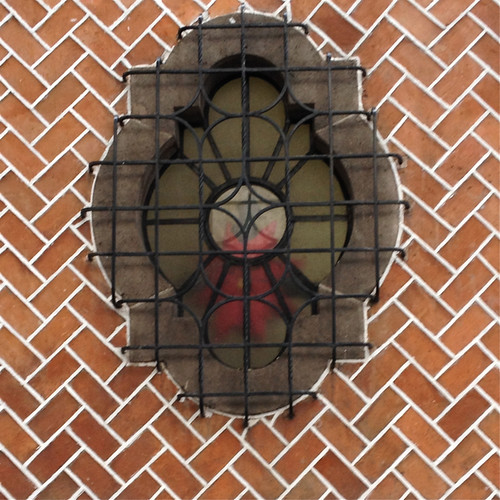

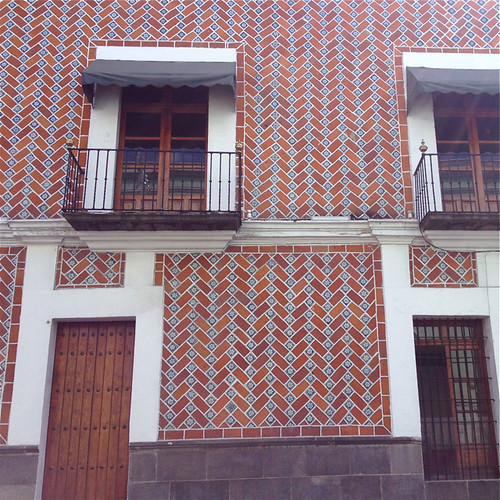
Given all this pattern and colour, it's perhaps predictable the Talavera Pottery with its riotous patterning was developed in Peubla. Some of the older and more beautiful examples, that I could never afford, are exquisite. These are simpler versions now produced for tourists but still lovely:

Unfortunately, photographs were banned at what, for me, was the highlight of our visit to Puebla. The Biblioteca Palafoxiana is the oldest public library in colonial Mexico. It was established in 1646 and the beautiful space in which it is still housed was built in 1733. There's a long, vaulted room with a worn floor of warm, rust-coloured tiles interspersed with blue and white patterned tiles. The mainly Latin language collection is housed in a double row of beautiful shelves with walkways for accessibility. Sometimes in the Western (northern?)world we can be very arrogant about the achievements of today's societies. One of the delights of travel is to be reminded of past successes.
We visited Merida, another of the grand colonial cities of Mexico, further to the east and the capital of Yucatan state. I love cities that have a grand central plaza - a zocalo. It provides a heart for the city. All the cities we'd so far visited - Mexico City, Oaxaca, and Puebla have grand zocalos; places for meeting up, for public celebrations, for drinking a leisurely coffee, and, most importantly, for strolling or making a paseo in the evenings. I particularly liked the Plaza Grande in Merida which had all these characteristics, but also offered insights to both the history and current culture of Merida.
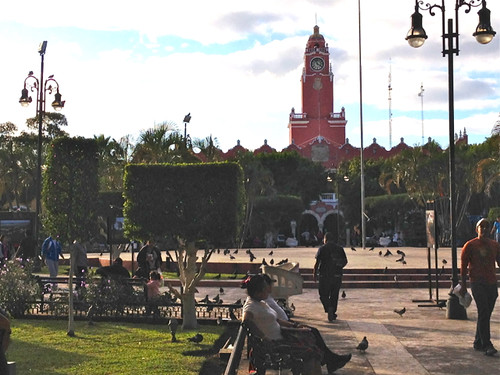
On one side of the Merida zocalo is the 1598 Catedral de San Ildefonso, more bulky and less decorated than the cathedrals of Oaxaca and Puebla, but probably more imposing as a consequence.


On another side is the facade of Casa de Montoya - the mid-sixteenth century residence of the Montoya family who colonised what is now Merida:


I loved the combination of austerity and decoration in this building, and can think of no more perfect patina than the weathered soft pink of its walls. The building is now maintained by a bank that has its premises inside, but the bank has also impeccably restored the front rooms of the Casa de Montoya as they would have been in the late nineteenth century. With one short visit you can imagine both the impact that Spanish colonisation must have had on the Mayan population in the mid-sixteenth century, and its continuity as an elite well into the nineteenth and twentieth centuries.
On a third side of the zocalo is the late nineteenth century Palacio de Gobierno, currently painted pistachio green. If you persist past the well-guarded entrance you discover a beautifully proportioned colonnaded building from which modern Merida is administered. What I hadn't anticipated, though maybe I should have, given the importance of the muralismo movement in Mexican art and history, was the series of 1970s murals depicting the history of Merida - with a particular focus on its Mayan foundation myths and the often troubled and confrontational relations between the colonisers and the Mayan inhabitants.


You can take a paseo around the central square and become aware of the grandeur and diversity of Mexican history. But the zocalo still has a role in people's daily lives. On the evening we arrived we went in urgent search of food and happened upon large numbers of people dancing to a salsa group in one of the streets that border the plaza. Old people, young people, couples, individuals. We were too hungry to linger but it was a good introduction to Merida's zocalo. Later we were told that the whole plaza has free wifi, and that there is a scheme that enables people to borrow laptops to use within the space. I imagine there must be learned studies of the significance of the zocalo in people's lives, but even to the casual tourist observer it seems to be a most humanising space.
We visited Chetumal, the capital of the state of Quintana Roo, in the south of the Yucatan Peninsula, on the border with Belize. Chetumal is definitely not one of the beautiful colonial cities of Mexico; in fact, the city was officially founded by the military as late as 1898, to protect the border that, after many years of disagreement, had finally been decided between Mexico and Great Britain. The small city has an air of practicality about it.

Internal immigration from other areas of Mexico is encouraged and there's the low-key bustle of people getting on with their daily lives. If you look, there's evidence of the Mayan character of the city and surrounding area. There's a small but well-displayed Museum of Mayan Culture where a dimly-lit recreation of the Mayan version of an underworld afterlife had Ana Maria enjoyably horrified.

There are a few reminders that the area around Chetumal is not only Mayan, but linked to the Caribbean. There are still occasional timber cottages in Chetumal - reminders of the British influence that was much disputed in this area in the eighteenth and nineteenth century. Just outside of Chetumal is Laguna de Bacalar, a large lake that, together with the Rio Hondo, provided access to the interior of the region for traders, settlers and even privateers and pirates. There's a small fort dating from 1733 that's been recently restored and reminds the visitor of the turbulent eighteenth century history of this region with conflict over territory between the major sea-going nations of the world.
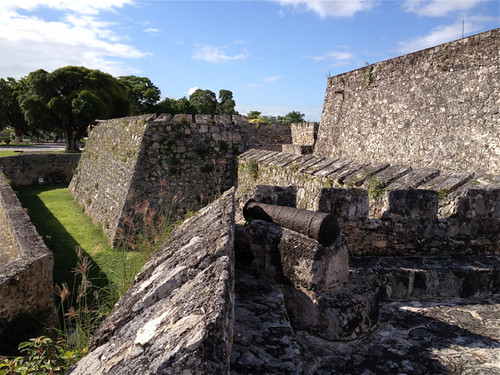
[My well-travelled grand-daughter was rather disappointed by the fort, comparing it unfavourably with the Castillo del Moro in Santiago de Cuba].
And finally, we visited Cancun to begin what turned out to be our challenging trip home to Australia. Such a contrast with so much we had seen. Cancun dates only from the mid-seventies, and if you focus only on the resorts and beaches and international hotels, you could be almost anywhere in the world.

I certainly know much more about Mexico now than I did before this trip. I'm pleased we were able to visit different places with different histories and cultures. I'm impressed by the strength of Mexican identity and by both the 'official' and everyday ways that local and national identities are interlinked and enriched. I feel there is still so much to see and learn.

I'm finding it difficult to round out the tale of my time in Mexico. I'm almost too tired, too full of what I've seen, and too sad about what I've missed to be coherent. With this trip I've really had to face up to the fact that I'm unable physically to manage what once I would have taken for granted. But, tired as I am, I want to capture the remainder of my Mexican trip before places become too scrambled in my mind.
We visited Puebla - a grand colonial city a couple of hours south of Mexico City.

Puebla was settled by the Spaniards in the 1531, and the planned gridded streets, elaborate, florid public buildings, decorated churches and colonnaded central plaza all reflect the status and wealth of Puebla during the colonial period. I particularly like the highly decorated surfaces of some of the grander buildings - especially those that intersperse decorative brickwork with local patterned tiles. It seems that too much decoration is never enough.




Given all this pattern and colour, it's perhaps predictable the Talavera Pottery with its riotous patterning was developed in Peubla. Some of the older and more beautiful examples, that I could never afford, are exquisite. These are simpler versions now produced for tourists but still lovely:

Unfortunately, photographs were banned at what, for me, was the highlight of our visit to Puebla. The Biblioteca Palafoxiana is the oldest public library in colonial Mexico. It was established in 1646 and the beautiful space in which it is still housed was built in 1733. There's a long, vaulted room with a worn floor of warm, rust-coloured tiles interspersed with blue and white patterned tiles. The mainly Latin language collection is housed in a double row of beautiful shelves with walkways for accessibility. Sometimes in the Western (northern?)world we can be very arrogant about the achievements of today's societies. One of the delights of travel is to be reminded of past successes.
We visited Merida, another of the grand colonial cities of Mexico, further to the east and the capital of Yucatan state. I love cities that have a grand central plaza - a zocalo. It provides a heart for the city. All the cities we'd so far visited - Mexico City, Oaxaca, and Puebla have grand zocalos; places for meeting up, for public celebrations, for drinking a leisurely coffee, and, most importantly, for strolling or making a paseo in the evenings. I particularly liked the Plaza Grande in Merida which had all these characteristics, but also offered insights to both the history and current culture of Merida.

On one side of the Merida zocalo is the 1598 Catedral de San Ildefonso, more bulky and less decorated than the cathedrals of Oaxaca and Puebla, but probably more imposing as a consequence.


On another side is the facade of Casa de Montoya - the mid-sixteenth century residence of the Montoya family who colonised what is now Merida:


I loved the combination of austerity and decoration in this building, and can think of no more perfect patina than the weathered soft pink of its walls. The building is now maintained by a bank that has its premises inside, but the bank has also impeccably restored the front rooms of the Casa de Montoya as they would have been in the late nineteenth century. With one short visit you can imagine both the impact that Spanish colonisation must have had on the Mayan population in the mid-sixteenth century, and its continuity as an elite well into the nineteenth and twentieth centuries.
On a third side of the zocalo is the late nineteenth century Palacio de Gobierno, currently painted pistachio green. If you persist past the well-guarded entrance you discover a beautifully proportioned colonnaded building from which modern Merida is administered. What I hadn't anticipated, though maybe I should have, given the importance of the muralismo movement in Mexican art and history, was the series of 1970s murals depicting the history of Merida - with a particular focus on its Mayan foundation myths and the often troubled and confrontational relations between the colonisers and the Mayan inhabitants.


You can take a paseo around the central square and become aware of the grandeur and diversity of Mexican history. But the zocalo still has a role in people's daily lives. On the evening we arrived we went in urgent search of food and happened upon large numbers of people dancing to a salsa group in one of the streets that border the plaza. Old people, young people, couples, individuals. We were too hungry to linger but it was a good introduction to Merida's zocalo. Later we were told that the whole plaza has free wifi, and that there is a scheme that enables people to borrow laptops to use within the space. I imagine there must be learned studies of the significance of the zocalo in people's lives, but even to the casual tourist observer it seems to be a most humanising space.
We visited Chetumal, the capital of the state of Quintana Roo, in the south of the Yucatan Peninsula, on the border with Belize. Chetumal is definitely not one of the beautiful colonial cities of Mexico; in fact, the city was officially founded by the military as late as 1898, to protect the border that, after many years of disagreement, had finally been decided between Mexico and Great Britain. The small city has an air of practicality about it.

Internal immigration from other areas of Mexico is encouraged and there's the low-key bustle of people getting on with their daily lives. If you look, there's evidence of the Mayan character of the city and surrounding area. There's a small but well-displayed Museum of Mayan Culture where a dimly-lit recreation of the Mayan version of an underworld afterlife had Ana Maria enjoyably horrified.

There are a few reminders that the area around Chetumal is not only Mayan, but linked to the Caribbean. There are still occasional timber cottages in Chetumal - reminders of the British influence that was much disputed in this area in the eighteenth and nineteenth century. Just outside of Chetumal is Laguna de Bacalar, a large lake that, together with the Rio Hondo, provided access to the interior of the region for traders, settlers and even privateers and pirates. There's a small fort dating from 1733 that's been recently restored and reminds the visitor of the turbulent eighteenth century history of this region with conflict over territory between the major sea-going nations of the world.

[My well-travelled grand-daughter was rather disappointed by the fort, comparing it unfavourably with the Castillo del Moro in Santiago de Cuba].
And finally, we visited Cancun to begin what turned out to be our challenging trip home to Australia. Such a contrast with so much we had seen. Cancun dates only from the mid-seventies, and if you focus only on the resorts and beaches and international hotels, you could be almost anywhere in the world.

I certainly know much more about Mexico now than I did before this trip. I'm pleased we were able to visit different places with different histories and cultures. I'm impressed by the strength of Mexican identity and by both the 'official' and everyday ways that local and national identities are interlinked and enriched. I feel there is still so much to see and learn.
Tuesday, December 3, 2013
Crossing the border for lunch
If you grow up in a country that's also an island, especially if it's as big as Australia, crossing a border is a big deal. You have to make a special journey, either by plane of boat, to make a border crossing. So the idea of going to another country for lunch was astounding for 6 year old Ana Maria, and still had a certain frisson for me at more than eleven times Ana Maria's age. We're in Chetumal, in the state of Quintana Roo in the far south-eastern tip of Mexico, right on the border with Belize. A friend of my daughter offered to drive us across the border to Belize for lunch of rice and beans.
The border crossing hardly lived up to our expectations.

We were simply waved through the border by immigration officials - no need to present identification and, sadly, no stamps in our passports.
Borders can be odd places - not quite one country; not quite the other; and sometimes spaces that are unclassifiable and global. Our brief visit to Belize included lunch in a casino dining room:
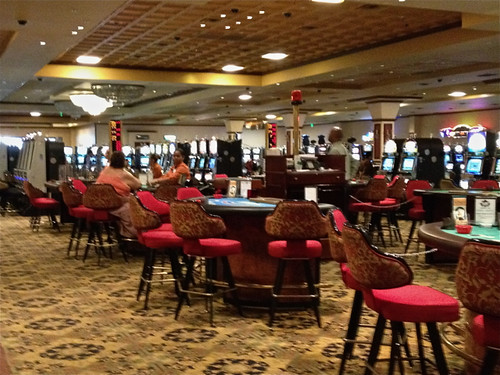
The casino itself could have been anywhere in the world, though our rice and beans with plantains, chicken and potato salad were distinctively and wonderfully Caribbean and we were served by English-speaking waiters in the only (officially) English-speaking country in central and south America.
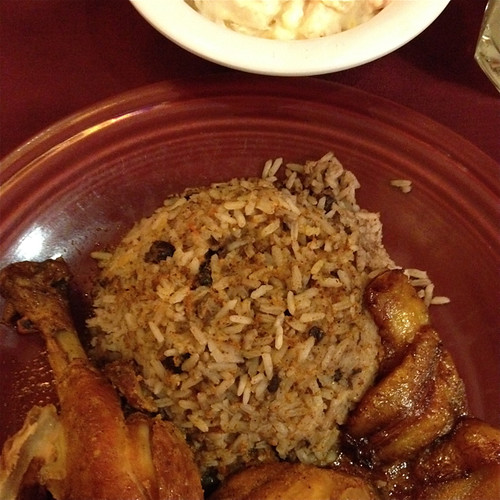
Lunch was followed by a short visit to a duty free shopping area. This had none of the try-hard gloss of duty-free shopping in large airports, but was an intersection of dusty streets selling cheap imports from India and Taiwan, probably to be on-sold at local markets for small profits. Again, we could have been in any such market around the world selling exactly the same cheaply-produced goods:
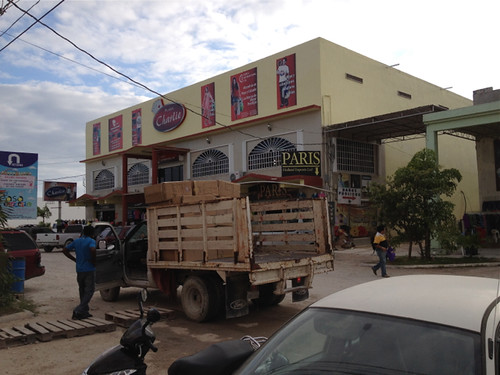
So we crossed the border for lunch and found a mixture of the local (the food) and a strangely borderless world.
The border crossing hardly lived up to our expectations.

We were simply waved through the border by immigration officials - no need to present identification and, sadly, no stamps in our passports.
Borders can be odd places - not quite one country; not quite the other; and sometimes spaces that are unclassifiable and global. Our brief visit to Belize included lunch in a casino dining room:

The casino itself could have been anywhere in the world, though our rice and beans with plantains, chicken and potato salad were distinctively and wonderfully Caribbean and we were served by English-speaking waiters in the only (officially) English-speaking country in central and south America.

Lunch was followed by a short visit to a duty free shopping area. This had none of the try-hard gloss of duty-free shopping in large airports, but was an intersection of dusty streets selling cheap imports from India and Taiwan, probably to be on-sold at local markets for small profits. Again, we could have been in any such market around the world selling exactly the same cheaply-produced goods:

So we crossed the border for lunch and found a mixture of the local (the food) and a strangely borderless world.
Thursday, November 28, 2013
Time in Oaxaca
We've decided that either Oaxaca has managed to get its tourism mix just right, and/or that we are the tourist demographic they're aiming for. Oaxaca attracts just enough tourists so that the facilities and services you need as a tourist are available (information, easily accessible day tours, a range of different foods) but not so many that you feel as if the tourists have swamped daily life for the locals.
So what did we find so attractive about Oaxaca? Of course there were the textiles of the last post, and the opportunities for wonderful shopping they provided. Top of the list, absolutely. But there were other attractions.
First, the charming streetscapes. Oaxaca is a low-rise town. As for medieval cities in Europe, the highest structures are the steeples of the churches.

Few buildings are higher than two storeys, so the streets have a regularity of scale that's pleasing and very human.
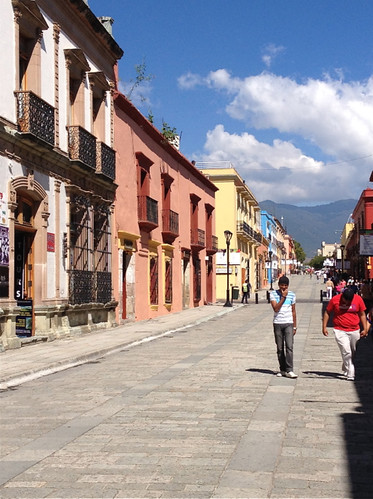
Then there's the colour. While there are a few grander buildings in rather austere stone, most of the buildings are painted in colours it would be impossible to replicate in other contexts - soft orange, sky blue, occasionally pistachio green, and my favourite, a golden, mustardy yellow.

Secondly, if you're interested in, but not obsessive about archeological sites, the splendid Monte Alban is only a twenty minute drive from the centre of Oaxaca. There's more than enough history, myth, grandeur and the sense of a lost civilization to keep you deeply interested for hours, without leaving you overwhelmed. Monte Alban was the foremost centre for Zapotec politics, society and economy for close to a thousand years, from around 500BC to 600AD when the habitation of the site petered out.

A hilltop was levelled to create a grand plaza - about 200 x 300 metres in size - and then surrounded by pyramidal buildings with different ritual or social purposes. As always with such evidence of past grandeur you are struck by the skill, strength and sheer hard labour that were needed to achieve such an impressive structure with only the most basic construction technologies.
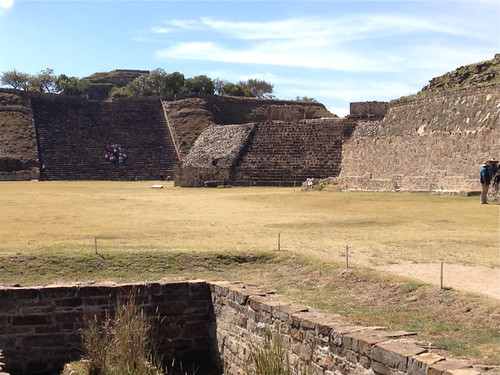
Third, if you are a fancier of old churches, Oaxaca will satisfy your fancies. At almost every corner there is a glimpse of steeples or church roofs with colourful tiled domes.
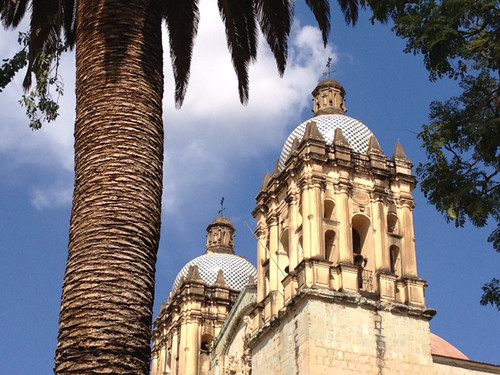
Most of the churches were built in the sixteenth century and are a reminder of the power and wealth of Spain and its colonial impact upon Mexico. The most imposing of the churches is the Templo de Santo Domingo de Guzman whose every millimetre is richly covered in decoration:
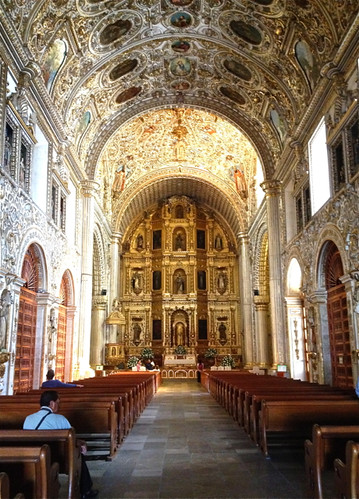
Just when you think you have seen the most elaborate church decoration ever, you turn to the side chapel dedicated to Our Lady of the Rosary and discover the already elaborate decoration is covered in what must have been kilos of gold leaf:

The churches are still in use - we happened upon a christening in the Rosary Chapel, and an ongoing mass in another church I visited - and they are clearly cared for and valued (though there are reports of gold and other effects being stolen in recent years). But the catholic church in Mexico is quite separate from the state and I was left with the impression that religion is a private affair and the churches are seen equally as part of their heritage as they are places of worship.
Fourth, there are some interesting museums, if you're a museum fan. We'd had rather a museum splurge in Mexico City and missed some of the recommended Oaxaca museums. But apart from the inspirational textile museum of the last post, we visited the Museum of Contemporary Art that displays exhibitions by well-known local artists. It's located in one of the grand old buildings of courtyards and colonnades and balconies, with rooms opening one into another to provide views of how the works you've just seen relate to those still to come.
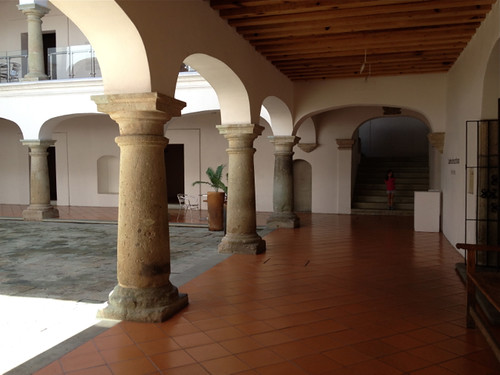
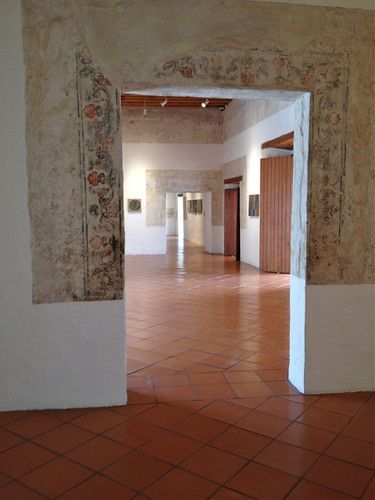
When the old building was adapted to its new purpose the painted decoration around some of the doors was preserved so that you are reminded that the building had had a history other than the spare, contemplative spaces that now exist.
The Jardin Etnobotanico was a different kind of museum. The space and buildings that are now a large garden had originally been the monastery for the Templo Santo Domingo and then, in the nineteenth century, a barracks and parade ground for the military. In the early 1990s there were plans to convert the space to a luxury hotel, but some of the famous local artists led a successful campaign to create a special kind of botanical garden - one that focuses on the plants of the Oaxaca region. The garden is now almost twenty years old and apart from being beautiful, it's fascinating, with special sections for plants for medicinal use, for food, for dyeing and other practical uses.
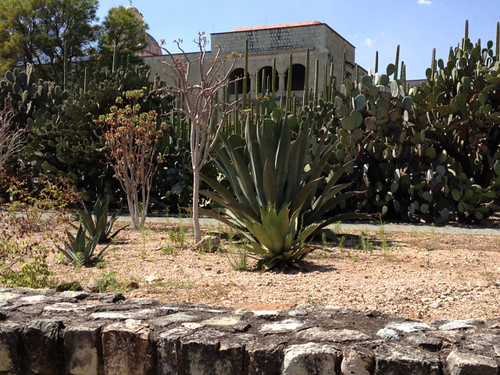

And the fifth and final reason - the food. Yum. I thought I wasn't a great fan of Mexican food, but clearly my exposure to it had been very limited. Between recommendations from a colleague of my daughter, and a remarkably well-informed edition of the Lonely Planet we had some wonderful meals (and drinks). The restaurants we tried used local foods in modern ways.


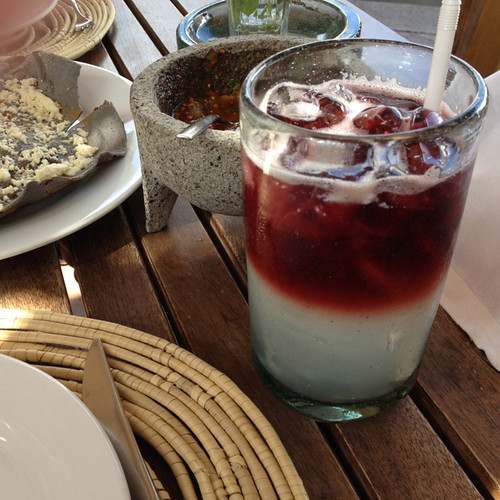

We had lots of mole sauces (the traditional bitter-chocolate based sauces that in Oaxaca come in black, red or yellow versions); beautifully soft, slow-cooked pork; local herbs; and the inevitable tortilla based accompaniments, including the blue tortillas topped with soft local cheese in the bottom left-hand photo. I even had risotto topped with foam! The risotto, by the way was wonderful with pumpkin, pumpkin flowers and caramelised pumpkin seeds.
Clearly, we've enjoyed our visit to Oaxaca. Wonderful. Highly recommended.
So what did we find so attractive about Oaxaca? Of course there were the textiles of the last post, and the opportunities for wonderful shopping they provided. Top of the list, absolutely. But there were other attractions.
First, the charming streetscapes. Oaxaca is a low-rise town. As for medieval cities in Europe, the highest structures are the steeples of the churches.

Few buildings are higher than two storeys, so the streets have a regularity of scale that's pleasing and very human.

Then there's the colour. While there are a few grander buildings in rather austere stone, most of the buildings are painted in colours it would be impossible to replicate in other contexts - soft orange, sky blue, occasionally pistachio green, and my favourite, a golden, mustardy yellow.

Secondly, if you're interested in, but not obsessive about archeological sites, the splendid Monte Alban is only a twenty minute drive from the centre of Oaxaca. There's more than enough history, myth, grandeur and the sense of a lost civilization to keep you deeply interested for hours, without leaving you overwhelmed. Monte Alban was the foremost centre for Zapotec politics, society and economy for close to a thousand years, from around 500BC to 600AD when the habitation of the site petered out.

A hilltop was levelled to create a grand plaza - about 200 x 300 metres in size - and then surrounded by pyramidal buildings with different ritual or social purposes. As always with such evidence of past grandeur you are struck by the skill, strength and sheer hard labour that were needed to achieve such an impressive structure with only the most basic construction technologies.

Third, if you are a fancier of old churches, Oaxaca will satisfy your fancies. At almost every corner there is a glimpse of steeples or church roofs with colourful tiled domes.

Most of the churches were built in the sixteenth century and are a reminder of the power and wealth of Spain and its colonial impact upon Mexico. The most imposing of the churches is the Templo de Santo Domingo de Guzman whose every millimetre is richly covered in decoration:

Just when you think you have seen the most elaborate church decoration ever, you turn to the side chapel dedicated to Our Lady of the Rosary and discover the already elaborate decoration is covered in what must have been kilos of gold leaf:

The churches are still in use - we happened upon a christening in the Rosary Chapel, and an ongoing mass in another church I visited - and they are clearly cared for and valued (though there are reports of gold and other effects being stolen in recent years). But the catholic church in Mexico is quite separate from the state and I was left with the impression that religion is a private affair and the churches are seen equally as part of their heritage as they are places of worship.
Fourth, there are some interesting museums, if you're a museum fan. We'd had rather a museum splurge in Mexico City and missed some of the recommended Oaxaca museums. But apart from the inspirational textile museum of the last post, we visited the Museum of Contemporary Art that displays exhibitions by well-known local artists. It's located in one of the grand old buildings of courtyards and colonnades and balconies, with rooms opening one into another to provide views of how the works you've just seen relate to those still to come.


When the old building was adapted to its new purpose the painted decoration around some of the doors was preserved so that you are reminded that the building had had a history other than the spare, contemplative spaces that now exist.
The Jardin Etnobotanico was a different kind of museum. The space and buildings that are now a large garden had originally been the monastery for the Templo Santo Domingo and then, in the nineteenth century, a barracks and parade ground for the military. In the early 1990s there were plans to convert the space to a luxury hotel, but some of the famous local artists led a successful campaign to create a special kind of botanical garden - one that focuses on the plants of the Oaxaca region. The garden is now almost twenty years old and apart from being beautiful, it's fascinating, with special sections for plants for medicinal use, for food, for dyeing and other practical uses.


And the fifth and final reason - the food. Yum. I thought I wasn't a great fan of Mexican food, but clearly my exposure to it had been very limited. Between recommendations from a colleague of my daughter, and a remarkably well-informed edition of the Lonely Planet we had some wonderful meals (and drinks). The restaurants we tried used local foods in modern ways.




We had lots of mole sauces (the traditional bitter-chocolate based sauces that in Oaxaca come in black, red or yellow versions); beautifully soft, slow-cooked pork; local herbs; and the inevitable tortilla based accompaniments, including the blue tortillas topped with soft local cheese in the bottom left-hand photo. I even had risotto topped with foam! The risotto, by the way was wonderful with pumpkin, pumpkin flowers and caramelised pumpkin seeds.
Clearly, we've enjoyed our visit to Oaxaca. Wonderful. Highly recommended.
Subscribe to:
Posts (Atom)

